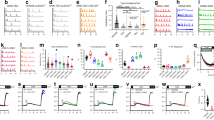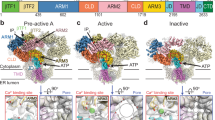Abstract
The inositol 1,4,5-trisphosphate receptor (InsP3R) is the main calcium(Ca2+) release channel in most tissues. Three isoforms have been identified1,2,3,4,5,6, but only types I and II InsP3R have been characterized7,8. Here we examine the functional properties of the type III InsP3R because this receptor is restricted to the trigger zone from which Ca2+ waves originate9,10,11 and it has distinctive InsP3-binding properties12,13. We find that type III InsP3R forms Ca2+ channels with single-channel currents that are similar to those of type I InsP3R; however, the open probability of type III InsP3R isoform increases monotonically with increased cytoplasmic Ca2+ concentration, whereas the type I isoform has a bell-shaped dependence on cytoplasmic Ca2+. The properties of type III InsP3R provide positive feedback as Ca2+ is released; the lack of negative feedback allows complete Ca2+ release from intracellular stores. Thus, activation of type III InsP3R in cells that express only this isoform results in a single transient, but global, increase in the concentration of cytosolic Ca2+. The bell-shaped Ca2+-dependence curve of type I InsP3R is ideal for supporting Ca2+ oscillations, whereas the properties of type III InsP3R are better suited to signal initiation.
This is a preview of subscription content, access via your institution
Access options
Subscribe to this journal
Receive 51 print issues and online access
$199.00 per year
only $3.90 per issue
Buy this article
- Purchase on Springer Link
- Instant access to full article PDF
Prices may be subject to local taxes which are calculated during checkout





Similar content being viewed by others
References
Furuichi, T.et al. Primary structure and functional expression of the inositol 1,4,5-trisphosphate-binding protein P400. Nature 342, 32–38 (1989).
Mignery, G., Sudhof, T. C., Takei, K. & De Camilli, P. Putative receptor for inositol 1,4,5-trisphosphate similar to ryanodine receptor. Nature 342, 192–195 (1989).
Sudhof, T. C., Newton, C. L., Archer, B. T., Ushkaryov, Y. A. & Mignery, G. A. Structure of a novel InsP3receptor. EMBO J. 10, 3199–3206 (1991).
Blondel, O., Takeda, J., Janssen, H., Seino, S. & Bell, G. I. Sequence and functional characterization of a third inositol trisphospate receptor subtype, IP3R-3, expressed in pancreatic islets, gastrointestinal tract, and other tissues. J. Biol. Chem. 268, 11356–11363 (1993).
Maranto, A. R. Primary structure, ligand binding, and localization of the human type 3 inositol 1,4,5-trisphosphate receptor expressed in intestinal epithelium. J. Biol. Chem. 269, 1222–1230 (1994).
Morgan, J. M., De Smedt, H. & Gillespie, J. I. Identification of three isoforms of the InsP3receptor in human myometrial smooth muscle. Pflugers Arch. 431, 697–705 (1996).
Bezprozvanny, I. & Ehrlich, B. Inositol (1,4,5)-trisphosphate gated Ca channels from canine cerebellum: divalent cation conduction properties and regulation by intraluminal Ca. J. Gen. Physiol. 104, 821–856 (1994).
Perez, P. J., Ramos-Franco, J., Fill, M. & Mignery, G. A. Identification and functional reconstitution of the type 2 inositol 1,4,5-trisphosphate receptor from ventricular cardiac myocytes. J. Biol. Chem. 272, 23961–23969 (1997).
Nathanson, M. H., Fallon, M. B., Padfield, P. J. & Maranto, A. R. Localization of the type 3 inositol 1,4,5-trisphosphate receptor in the Ca2+ wave trigger zone of pancreatic acinar cells. J. Biol. Chem. 269, 4693–4696 (1994).
Thorn, P., Lawrie, A., Smith, P., Gallacher, D. & Petersen, O. H. Local and global cytosolic Ca2+ oscillations in exocrine cells evoked by agonists and inositol trisphosphate. Cell 74, 661–668 (1993).
Kasai, H., Li, Y. & Miyashita, Y. Subcellular distribution of Ca2+ release channels underlying Ca2+ waves and oscillations in exocrine pancrease. Cell 74, 669–677 (1993).
Yoneshima, H., Miyawaki, A., Takayuki, M., Teiichi, F. & Mikoshiba, K. Ca2+ differentially regulates the ligand-affinity states of the type 1 and type 3 inositol 1,4,5-trisphosphate receptors. Biochem. J. 322, 591–596 (1997).
Cardy, T. J. A., Traynor, D. & Taylor, C. W. Differential regulation of types-1 and -3 inositol trisphosphate receptors by cytosolic Ca2+. Biochem. J. 328, 785–793 (1997).
Wojcikiewicz, R. J. H. Type I,II,III inositol 1,4,5-trisphosphate receptors are unequally susceptible to down-regulation and are expressed in markedly different proportions in different cell types. J. Biol. Chem. 270, 11678–11683 (1995).
DeLisle, S.et al. Expression of inositol 1,4,5-trisphosphate receptors changes the Ca signal in Xenopus oocytes. Am. J. Physiol. 270, C1255–C1261 (1996).
Bezprozvanny, I., Watras, J. & Ehrlich, B. E. Bell-shaped calcium-response curves of Ins(1,4,5)P3- and calcium-gated channels from endoplasmic reticulum of cerebellum. Nature 351, 751–754 (1991).
Kaftan, E. J., Ehrlich, B. E. & Watras, J. Inositol 1,4,5-trisphosphate (InsP3) and calcium interact to increase the dynamic range of InsP3receptor-dependent calcium signaling. J. Gen. Physiol. 110, 529–538 (1997).
Thomas, A. P., Bird, G. S., Hajinoczky, G., Robb-Gaspers, L. D. & Putney, J. W. Spatial and temporal aspects of cellular calcium signaling. FASEB J. 10, 1505–1517 (1996).
Dubyak, G. R. & El-Moatassim, C. Signal transduction via P2-purinergic receptors for extracellular ATP and other nucleotides. Am. J. Physiol. Cell Physiol. 265, C577–C606 (1993).
Cao, D., Lin, G., Westphale, E., Beyer, E. & Steinberg, T. Mechanisms for the coordination of intercellular calcium signaling in insulin-secreting cells. J. Cell Sci. 110, 497–504 (1997).
Dixon, C., Woods, N., Cuthbertson, K. & Cobbold, P. Evidence for two Ca2(+)-mobilizing purinoceptors on rat hepatocytes. Biochem. J. 269, 499–502 (1990).
Bootman, M., Berridge, M. & Lipp, P. Cooking with calcium: the recipes for composing global signals from elementary events. Cell 91, 367–373 (1997).
Parker, I. & Yao, Y. Ca2+ transients associated with openings of inositol trisphosphate-gated channels in Xenopus oocytes. J. Physiol. 49, 663–668 (1996).
Lipp, P., Thomas, D., Berridge, M. & Bootman, M. Nuclear calcium signalling by individual cytoplasmic calcium puffs. EMBO J. 16, 7166–7173 (1997).
Glennon, M. C., Bird, G. S. J., Kwan, C.-Y. & Putney, J. W. Actions of vasopressin and the Ca2+-ATPase inhibitor, thapsigargin, on Ca2+ signaling in hepatocytes. J. Biol. Chem. 267, 8230–8233 (1992).
Cameron, A.et al. Calcineurin associated with the inositol 1,4,5-trisphosphate receptor–FKBP12 complex modulates Ca2+ flux. Cell 83, 463–472 (1995).
Petersen, C. C., Toescu, E. C., Potter, B. V. L. & Petersen, O. H. Inositol triphosphate produces different patterns of cytoplasmic Ca2+ spiking depending on its concentration. FEBS Lett. 293, 179–182 (1991).
Nathanson, M. H., Padfield, P. J., O'Sullivan, A. J., Burgstahler, A. D. & Jamieson, J. D. Mechanism of Ca2+ wave propagation in pancreatic acinar cells. J. Biol. Chem. 267, 18118–18121 (1992).
Grynkiewicz, G., Poenie, M. & Tsien, R. Anew generation of Ca2+ indicators with greatly improved fluorescence properties. J. Biol. Chem. 260, 3440–3450 (1985).
Schlosser, S. F., Burgstahler, A. D. & Nathanson, M. H. Isolated rat hepatocytes can signal to other hepatocytes and bile duct cells by release of nucleotides. Proc. Natl Acad. Sci. USA 93, 9948–9953 (1996).
Acknowledgements
We thank E. Kaftan for all his assistance during the execution of these experiments, J. Putney for suggesting RIN-5F cells as source of type III InsP3R, and J. Brown for comments on the manuscript. This work was supported by NIH grants (to B.E.E. and M.H.N.), an Established Investigator Grant from the American Heart Association (to M.H.N.), and by the Yale Liver Center.
Author information
Authors and Affiliations
Corresponding author
Rights and permissions
About this article
Cite this article
Hagar, R., Burgstahler, A., Nathanson, M. et al. Type III InsP3 receptor channel stays open in the presence of increased calcium. Nature 396, 81–84 (1998). https://doi.org/10.1038/23954
Received:
Accepted:
Issue Date:
DOI: https://doi.org/10.1038/23954
This article is cited by
-
Stores, Channels, Glue, and Trees: Active Glial and Active Dendritic Physiology
Molecular Neurobiology (2019)
-
The interplay between plasma membrane and endoplasmic reticulum Ca2+ATPases in agonist-induced temporal Ca2+ dynamics
Journal of Bioenergetics and Biomembranes (2014)
-
Loss of endoplasmic reticulum Ca2+ homeostasis: contribution to neuronal cell death during cerebral ischemia
Acta Pharmacologica Sinica (2013)
-
Selective modulation of subtype III IP3R by Akt regulates ER Ca2+ release and apoptosis
Cell Death & Disease (2012)
-
Mapping Molecular Memory: Navigating the Cellular Pathways of Learning
Cellular and Molecular Neurobiology (2012)
Comments
By submitting a comment you agree to abide by our Terms and Community Guidelines. If you find something abusive or that does not comply with our terms or guidelines please flag it as inappropriate.



